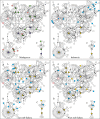African origin for Madagascan dogs revealed by mtDNA analysis
- PMID: 26064658
- PMCID: PMC4453261
- DOI: 10.1098/rsos.140552
African origin for Madagascan dogs revealed by mtDNA analysis
Abstract
Madagascar was one of the last major land masses to be inhabited by humans. It was initially colonized by Austronesian speaking Indonesians 1500-2000 years ago, but subsequent migration from Africa has resulted in approximately equal genetic contributions from Indonesia and Africa, and the material culture has mainly African influences. The dog, along with the pig and the chicken, was part of the Austronesian Neolithic culture, and was furthermore the only domestic animal to accompany humans to every continent in ancient times. To illuminate Madagascan cultural origins and track the initial worldwide dispersal of dogs, we here investigated the ancestry of Madagascan dogs. We analysed mtDNA control region sequences in dogs from Madagascar (n=145) and compared it with that from potential ancestral populations in Island Southeast Asia (n=219) and sub-Saharan Africa (n=493). We found that 90% of the Madagascan dogs carried a haplotype that was also present in sub-Saharan Africa and that the remaining lineages could all be attributed to a likely origin in Africa. By contrast, only 26% of Madagascan dogs shared haplotypes with Indonesian dogs, and one haplotype typical for Austronesian dogs, carried by more than 40% of Indonesian and Polynesian dogs, was absent among the Madagascan dogs. Thus, in contrast to the human population, Madagascan dogs seem to trace their origin entirely from Africa. These results suggest that dogs were not brought to Madagascar by the initial Austronesian speaking colonizers on their transoceanic voyage, but were introduced at a later stage, together with human migration and cultural influence from Africa.
Keywords: Austronesian expansion; Canis familiaris; Indian Ocean exchange; Madagascar; cultural diffusion; mtDNA.
Figures



References
-
- Dewar RE, Wright HT. 1993. The culture history of Madagascar. J. World Prehistory 7, 417–466. (doi:10.1007/BF00997802) - DOI
-
- Adelaar A. 2006. The Indonesian migrations to Madagascar: making sense of the multidisciplinary evidence. In Austronesian diaspora and the ethnogeneses of people in Indonesian archipelago: Proc. Int. Symp. (eds Simanjuntak T, Pojoh IHE, Hisyam M), pp. 205–232. Jakarta, Indonesia: Indonesian Institute of Science.
-
- Dewar RE. 1995. Of nets and trees: untangling the reticulate and dendritic in Madagascar's prehistory. World Archaeol. 26, 301–318. (doi:10.1080/00438243.1995.9980279) - DOI
-
- Bellwood PS. 2005. First farmers: the origins of agricultural societies. Malden, MA: Blackwell Publishing.
-
- Adelaar A. 1995. Asian roots of the Malagasy: a linguistic perspective. Bijdragen Tot De Taal- Land- En Volkenkunde 151, 325–356. (doi:10.1163/22134379-90003036) - DOI
LinkOut - more resources
Full Text Sources
Other Literature Sources

